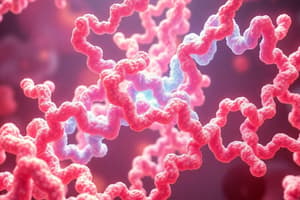Podcast
Questions and Answers
Which amino acid is primarily associated with the condition classic homocysteinuria?
Which amino acid is primarily associated with the condition classic homocysteinuria?
- Arginine
- Cysteine (correct)
- Methionine
- Ornithine
Cystinosis is characterized by a defect in the dibasic amino acid transporter in the kidney.
Cystinosis is characterized by a defect in the dibasic amino acid transporter in the kidney.
False (B)
Name a specialized product derived from cysteine.
Name a specialized product derived from cysteine.
Co-A or Taurine
Which amino acid is essential and must be obtained through diet?
Which amino acid is essential and must be obtained through diet?
Cysteine is a non-polar amino acid.
Cysteine is a non-polar amino acid.
The methyl donor involved in the conversion of homocysteine to methionine is __________.
The methyl donor involved in the conversion of homocysteine to methionine is __________.
Match the following defects with their associated conditions:
Match the following defects with their associated conditions:
What is the primary risk factor associated with homocysteine levels?
What is the primary risk factor associated with homocysteine levels?
Cysteine can be synthesized from __________.
Cysteine can be synthesized from __________.
Match the following conditions with their associated descriptions:
Match the following conditions with their associated descriptions:
Which amino acids make up glutathione?
Which amino acids make up glutathione?
Cysteine supplementation is a treatment for classical homocysteinuria.
Cysteine supplementation is a treatment for classical homocysteinuria.
What is the clinical feature characterized by elongated fingers in classical homocysteinuria?
What is the clinical feature characterized by elongated fingers in classical homocysteinuria?
The biochemical defect in classical homocysteinuria results in an increase of __________ in the blood.
The biochemical defect in classical homocysteinuria results in an increase of __________ in the blood.
Match the following terms with their descriptions:
Match the following terms with their descriptions:
Which of the following roles does glutathione NOT perform?
Which of the following roles does glutathione NOT perform?
Homocysteine levels decrease with deficiency of B vitamins such as B6, folic acid, and B12.
Homocysteine levels decrease with deficiency of B vitamins such as B6, folic acid, and B12.
What enzyme-related test is used for the lab diagnosis of classical homocysteinuria?
What enzyme-related test is used for the lab diagnosis of classical homocysteinuria?
Flashcards
Cysteine & Methionine
Cysteine & Methionine
Sulfur-containing amino acids, with cysteine being a polar amino acid and methionine being a non-polar one.
Homocysteine
Homocysteine
A sulfur-containing amino acid derivative, a crucial intermediate in the conversion of methionine to cysteine and vice versa.
SAM (S-adenosyl methionine)
SAM (S-adenosyl methionine)
A molecule that transfers methyl groups in biochemical reactions. Crucial in converting homocysteine into methionine.
Cysteine supplementation
Cysteine supplementation
Signup and view all the flashcards
Methionine restriction
Methionine restriction
Signup and view all the flashcards
Homocysteine's role in methylation
Homocysteine's role in methylation
Signup and view all the flashcards
S-Adenosylmethionine (SAM)
S-Adenosylmethionine (SAM)
Signup and view all the flashcards
Classic vs. Non-classic Homocystinuria
Classic vs. Non-classic Homocystinuria
Signup and view all the flashcards
Cystinuria Cause
Cystinuria Cause
Signup and view all the flashcards
Cystinosis Defect
Cystinosis Defect
Signup and view all the flashcards
Glutathione function (Amino acid transport)
Glutathione function (Amino acid transport)
Signup and view all the flashcards
Glutathione function (Free radical scavenging)
Glutathione function (Free radical scavenging)
Signup and view all the flashcards
Glutathione function (Conjugation/Phase II)
Glutathione function (Conjugation/Phase II)
Signup and view all the flashcards
Classical Homocysteinuria (Biochemical defect)
Classical Homocysteinuria (Biochemical defect)
Signup and view all the flashcards
Classical Homocysteinuria (Clinical Features)
Classical Homocysteinuria (Clinical Features)
Signup and view all the flashcards
Homocysteine-related deficiencies
Homocysteine-related deficiencies
Signup and view all the flashcards
Folate Trap
Folate Trap
Signup and view all the flashcards
Coenzyme role of Glutathione
Coenzyme role of Glutathione
Signup and view all the flashcards
Study Notes
Sulphur Containing Amino Acids
-
Co-A: Pantothenic acid, involved in the conjugation of bile acids.
-
Glutathione: A tripeptide (gamma-glutamyl cysteinyl glycine, GSH), comprising three amino acids: glutamic acid, cysteine, and glycine.
Functions of Glutathione
-
Amino Acid Transport: Utilizes the Meister's cycle/gamma-glutamyl cycle; crucial in the intestine, brain, and kidneys, utilizing ATP.
-
Free Radical Scavenging: Reduced glutathione protects against free radicals, reacting with harmful compounds to convert to an oxidized form. This process involves NADP+ and NADPH+H+. The conversion and subsequent recycling depends on two enzymes: Glutathione peroxidase and Glutathione reductase, part of the pentose phosphate pathway (HMP shunt).
-
Conjugation/Phase II Reactions: Involved in the conjugation of xenobiotics (preservatives, drugs) to aid excretion.
-
Coenzyme Role: Glutathione acts as a coenzyme, supporting cis-trans isomerase role in the conversion of maleyl acetoacetate to fumaryl acetoacetate.
Additional Information (cont.)
- Cystinuria: A defect in the dibasic amino acid transporter in the kidney, affecting the reabsorption of cystine.
- Classical homocysteinuria: A defect related to the metabolic pathway of methionine, leading to an accumulation of homocysteine in the blood, urine, and causing synthesis of cysteine and elevated homocysteine levels.
- Clinical features of classical homocysteinuria: Asymptomatic initially and is characterized by skeletal deformities.
- Cystinosis: A lysosomal storage disorder, characterized by a defect in the H+-driven lysosomal cystine transporter (CTNS gene).
- Disorders of methionine and cysteine metabolism: Issues with transport and synthesis of methionine and cysteine.
- Folic acid deficiency: A deficiency that leads to the depletion of THFA, leading to homocysteine accumulation and impacting other metabolic processes.
Other Key Concepts
- S-adenosylmethionine (SAM): A key methyl donor in various metabolic processes, involving a methyl group transfer from methionine.
- Methionine to Homocysteine: The metabolic pathway involves enzymes like methyl transferase to convert methionine to homocysteine.
- Other Disorders: Include oast house syndrome/Smith–Lemli–Opitz syndrome and primary hypermethioninemia, identified by certain symptoms like a boiled cabbage smell due to a buildup of methionine.
- Products of cysteine: Includes compounds like betamercaptoethanolamine, crucial to Coenzyme-A synthesis, Co-A, Pantothenic acid, and Taurine, involved in conjugation with bile acids.
Studying That Suits You
Use AI to generate personalized quizzes and flashcards to suit your learning preferences.



